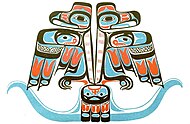|
Thunderbird (mythology)
 The thunderbird is a mythological bird-like spirit in North American indigenous peoples' history and culture. It is considered a supernatural being of power and strength.[1] It is frequently depicted in the art, songs, and oral histories of many Pacific Northwest Coast cultures,[citation needed] but is also found in various forms among some peoples of the American Southwest,[citation needed] US East Coast,[citation needed] Great Lakes,[1] and Great Plains.[1] DescriptionThe thunderbird is said to create thunder by flapping its wings (Algonquian[2]), and lightning by flashing its eyes (Algonquian, Iroquois[3]). Across cultures, thunderbirds are generally depicted as birds of prey, or hybrids of humans and birds.[1] Thunderbirds are often viewed as protectors, sometimes intervening on people's behalf, but expecting veneration, prayers, and gifts.[1] Archaeologically, sites containing depictions of thunderbirds have been found dating to the past 4,000 years.[1] Petroglyphs of thunderbirds are found near Twin Bluffs, Wisconsin. They are in a shelter that was probably used c. 250 BCE to 1500.[4] By peopleAlgonquianTribal signatures using thunderbirds on the Great Peace of Montreal The thunderbird myth and motif is prevalent among Algonquian peoples in the Northeast, i.e., Eastern Canada (Ontario, Quebec, and eastward) and Northeastern United States, and the Iroquois peoples (surrounding the Great Lakes).[5] The discussion of the Northeast region has included Algonquian-speaking people in the Lakes-bordering U.S. Midwest states (e.g., Ojibwe in Minnesota[6]). In Algonquian mythology, the thunderbird controls the upper world while the underworld is governed by the underwater panther or Great Horned Serpent. The thunderbird creates not just thunder (with its wing-flapping) but lightning bolts, which it casts at the underworld creatures.[2] Thunderbird in this tradition may be depicted as a spreadeagled bird (wings horizontal head in profile), but also quite common with the head facing forward, thus presenting an X-shaped appearance overall[6] (see under §Iconography below). Ojibwe The Ojibwe version of the myth states that the thunderbirds were created by Nanabozho to fight the underwater spirits. Thunderbirds also punished humans who broke moral rules. The thunderbirds lived in the four directions and arrived with the other birds in the springtime. In the fall, they migrated south after the end of the underwater spirits' most dangerous season.[7] MenomineeThe Menominee of Northern Wisconsin tell of a great mountain that floats in the western sky on which dwell the thunderbirds. They control the rain and hail, and delight in fighting and deeds of greatness. They are the enemies of the great horned snakes (the Misikinubik) and have prevented these from overrunning the earth and devouring humankind. They are messengers of the Great Sun himself.[8] Siouan
 The thunderbird motif is also seen in Siouan-speaking peoples, which include tribes traditionally occupying areas around the Great Lakes. Ho-ChunkHo-Chunk tradition states that a man who has a vision of a thunderbird during a solitary fast will become a war chief of the people.[9] Arikara
Ethnographer George Amos Dorsey transcribed a tale from the Arikaras with the title The Boy who befriended the Thunderbirds and the Serpent: a boy named Antelope-Carrier finds a nest with four young thunderbirds; their mother comes and tells the human boy that a two-headed Serpent comes out of the lake to eat the young.[10] IconographyX-shapesIn Algonquian images, an X-shaped thunderbird is often used to depict the thunderbird with its wings alongside its body and the head facing forwards instead of in profile.[5] The depiction may be stylized and simplified. A headless X-shaped thunderbird was found on an Ojibwe midewiwin disc dating to 1250–1400 CE.[11] In an 18th-century manuscript (a "daybook" ledger) written by the namesake grandson of Governor Matthew Mayhew, the thunderbird pictograms varies from "recognizable birds to simply an incised X".[12] Non-indigenous scientific interpretations American science historian and folklorist Adrienne Mayor and British historian Tom Holland have both suggested that indigenous thunderbird stories are based on discoveries of pterosaur fossils by Native Americans.[13][14] Outside North AmericaSimilar beings appear in mythologies the world over. Examples include the Chinese thunder-god Leigong, the Hindu Garuda and the African lightning bird.[15] In popular culture
See alsoReferences
Sources
External links
|
||||||||||||||



